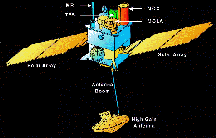

MARS GLOBAL SURVEYOR STATUS
The Mars Global Surveyor Project (MGS) has completed three very important milestones during May in its path toward launch in November 1996.
First, we have completed the Spacecraft Critical Design Review, a three day presentation of all of the details of the spacecraft design and the final plans to build and test it, presented by our industrial partner, Lockheed Martin Astronautics. Second, we completed the Project Critical Design Review, in which we examined all parts of the project (spacecraft, science instruments, mission design) and how they will work together for launch and in flight to Mars. Finally, we had an Independent Readiness Review in which a group of experts from NASA examine items that pose significant risks in our ability to reach the launch date with everything ready.
The special groups of experts that assessed the results of each of the reviews found that MGS was progressing well on its plan of work to be ready for launch on time. Everyone working on the project was very pleased with these results of their hard work.

We are getting very close to the start of what is called ATLO ( pronounced AT-low), the assembly, test and launch operations of the spacecraft. Assembly of the spacecraft begins in September followed by electrical then environmental testing in later months. Testing of much of the already built spacecraft electronics and structural pieces is already underway. Many of the new electronics for the spacecraft and the science payload are in the middle of their assembly processes. The first science instrument, the Ultra Stable Oscillator, which is used to conduct Radio Science experiments, will be ready in July.
We have been spending a lot of time developing the aerobraking capability that will use the drag of the upper Martian atmosphere to help put the spacecraft into the proper orbit for making the science observations of the planet. We recently made changes to the spacecraft design to add a small extra wing - which we call "flaps" - to the end of each of the two solar panels. The backside of the solar panels provide most of the area against which the atmosphere acts to provide the drag we need. The extra area provided by these new "flaps" gives us more resiliency against unexpected changes in the atmosphere and gives us much more confidence that aerobraking will work as predicted. Aerobraking is very important to MGS because it allows us to change our orbit at Mars without have to take a lot of fuel with us for our on-board rocket engines.
[Note to editor: It would be a good idea to put a color image of the spacecraft in at this point, with call out lines to the two new flaps.]
In another innovation, we are about to begin putting our engineers at JPL in Pasadena, CA, closer to our industrial partners at Lockheed Martin Astronautics in Denver, CO, by means of a "virtual" working environment using small TV cameras connected to our computers. Computers in Pasadena and Denver are in turn connected to each other through the Internet. This lets engineers who are sitting a thousand miles apart work like they are sitting across the table from each other. Their computer screens will not only show the information that they are working on, but their computers will now be able to show their colleagues and allow voice communication between them at the same time.



